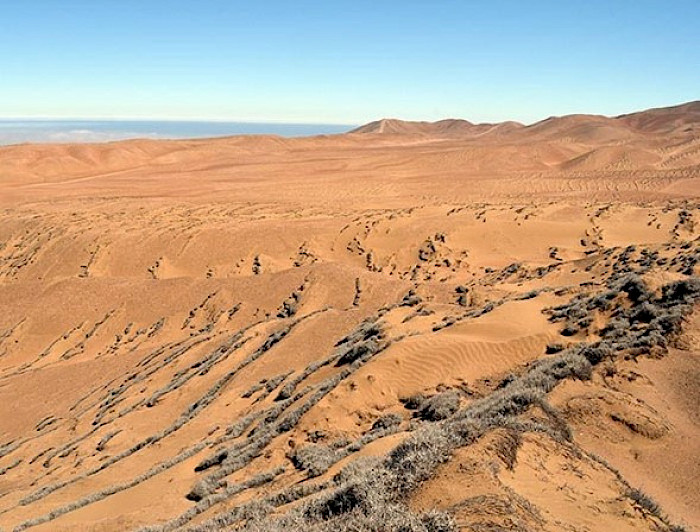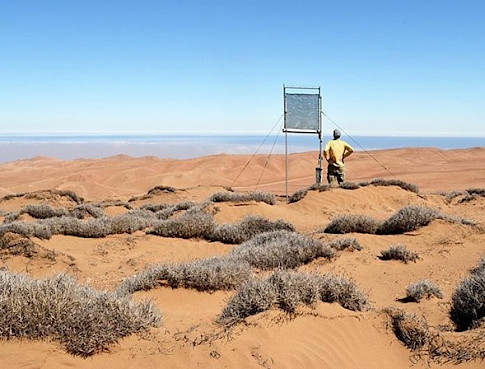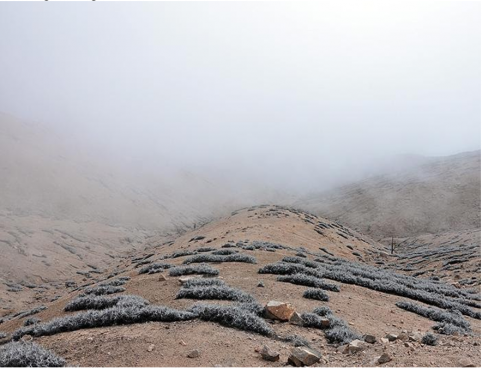Plants Living on the Edge of Aridity in the Atacama Desert
Better known as airplants, tillandsias are unique species capable of capturing water from the ground and the fog. This particularity has made them excellent bio-indicators of climate change and allows us to learn more about fog as a water resource in the Atacama Desert. Researchers from the UC Atacama Desert Center and the University of Heidelberg, Germany, have made essential findings, published in a special issue of the Plant Systematics and Evolution journal.

photo_camera Researchers from the UC Atacama Desert Centre and the University of Heidelberg, Germany, studied tillandsias or airplants for years. Due to its characteristics, this particular plant can provide crucial clues regarding fog and climate change. (Photo by: Josefina Hepp)
Some plants do not have roots.
Unlike other plants, instead of absorbing water from the ground, these species can capture it from the fog or camanchaca, the only permanent source of fresh water in the coastal desert of Atacama, the driest desert on Earth.
Thanks to small filaments (trichomes) on their leaves, these plants "drink" tiny drops.
That's why they are called airplants and belong to the same family as pineapples and chaguales (Bromeliaceae).
In Chile, one of these species: Tillandsia landbeckii, is being studied as an indicator of fog.
The plant covers some limited and scattered areas in the Coastal Mountain Range of the desert in the Tarapacá region and forms communities called "tillandsiales" or "calanchucales."
What have we learned about the plant in recent years? Considering its dependence on fog as a water source, what conditions can be projected in the future?
Researchers from the Atacama Desert Center (CDA) of Universidad Católica and Heidelberg answer these questions.
Juan Luis García, director of the CDA and professor at the Institute of Geography, highlighted the Chilean-German partnership:
"It has allowed us to understand specificities of the fog climate and its associated ecosystems in this hyper-arid region. Furthermore, the use of technology and the installation of seven new meteorological stations covering the area of influence of the fog provide unprecedented data that reveal the local characteristics of the atmosphere where tillandsias live."
This research is particularly relevant since the fog oases and Tillandsiales where biodiversity proliferates —in response to the frequency of the camanchaca— are considered to be in retreat. Therefore, it is critical to monitor changes in the desert.
Several advances of this work were published by the Plant Systematics and Evolution journal in Living at its dry limits - Tillandsiales in the Atacama Desert collection (2021).
The Role of Bacteria
"Soil Bacterial Community Structure of Fog‐Dependent Tillandsia Landbeckii Dunes in the Atacama Desert" is a paper that studies the role of soil microbial communities (Alfaro, F.D., Manzano, M., Almiray, C. et al., 2021).
In natural systems, plants modify soil properties by exuding carbon-rich compounds. In turn, soils influence plant growth through microbial activity, which allows, among other things, the fixation and capture of essential nutrients such as nitrogen and phosphorus.
This type of symmetrical interaction, called plant-soil feedback, is present in most of the planet's ecosystems.
An asymmetric example of this interaction exists in the Atacama Desert, where a group of plants of the genus Tillandsia persists thanks to the capture of water and resources from the mist coming from the Pacific Ocean.
Since they do not have functional roots, they directly interact with soils.
However, the researchers found that the organic matter and leaf litter they produce allows for the development of diverse communities of microorganisms at the base of these plants, which contrasts with bare or vegetation-free soils around them, where there is almost no microbial diversity and activity.
According to researcher Fernando Alfaro, CDA collaborator and professor at Universidad Mayor:
"These results reinforce the idea that extreme systems, such as those of northern Chile, represent natural experiments, where organisms and biological communities—in this case, plants and soil microbial communities—develop strategies that have allowed them to overcome some of the most stressful conditions on the planet, such as extreme aridity and high incidence of ultraviolet radiation.
Furthermore, the research's findings provide important evidence of the critical role of mist and its dynamics on the persistence of communities in one of the driest places on the planet."
Following the Fog

The daily and seasonal cycles of fog have been the subject of several kinds of research, and today we have a good knowledge of its temporal dynamics.
But when we apply this dynamism to the territory, we still do not know its actual scope and variations over time.
That is the subject of "Spatial Distribution and Interannual Variability of Coastal Fog And Low Clouds Cover in the Hyperarid Atacama Desert and Implications for Past and Present Tillandsia Landbeckii Ecosystems" (Del Río, C., Lobos-Roco, F., Latorre, C. et al., 2021)
This article approached fog from a Spatio-temporal perspective and analyzed its distribution, trend, and interannual variability in recent decades.
The spatial variations of fog were significant to understand, as the mist is the water and nutrient support for unique ecosystems, such as Tillandsiales.
The findings show a relationship between the presence of fog and its distribution with the cold and warm phases of the El Niño phenomenon. For example, fog increases during the winter-spring cold phase (La Niña) and summer during the warm phase (El Niño).
Another significant result was that during the period of the most incredible presence of fog in the area (September), weak negative (positive) trends of moisture and low cloud presence were observed above (below) 1000 m a. s. l.
The latter may be crucial for the survival of Tillandsia landbeckii, since it is precisely above that altitude where most Tillandsiales are located. This species has historically been sensitive to changes in fog.
As Camilo del Río, professor at the Institute of Geography, explained:
"One of our big questions in recent years is what to expect from the presence of fog under climate change conditions. Here we take a new step in understanding what happens to the presence and distribution of fog when there is a variation in the ocean-atmospheric factors. Understanding these changes in fog is crucial both for developing ecosystem conservation strategies and for its use as a water resource. These issues are part of our present and future challenges."
Knowing the fog

Despite the extensive area covered by the coastal fog desert in the Atacama (between 18-32° S), there is a lack of understanding of its most notable characteristics, including:
- the water potential of fog,
- the frequency of its presence, spatial gradients
- or its effect on ecosystems, such as Tillandsia fields.
Learning more about this phenomenon is the objective of "Climate and Coastal Low-Cloud Dynamic in the Hyperarid Atacama Fog Desert and the Geographic Distribution of Tillandsia Landbeckii (Bromeliaceae) Dune Ecosystems" (García, JL., Lobos-Roco, F., Schween, J.H. et al., 2021)
This research analyzed new meteorological data for the foggiest season (July-August-September, JAS) in 2018 and 2019.
The UC-Heidelberg consortium weather stations studies include sites in the Coastal Mountain Range in the hyper-arid Atacama: Cerro Oyarbide and the UC Atacama Station in Alto Patache, in Tarapacá region.
One of the main findings was that fog presence and fog water yields tend to be negatively related to both distances to the coast and elevation.
The coastal fog climate of Tarapacá is characterized by its high dynamism with an exchange of air masses from the interior and the ocean. An important finding is that fog "visits" Tillandsiales only 6% of the wettest season (JAS).
In other words, these plants adapt to the most extreme aridity conditions and high fluctuation of atmospheric humidity.
On the other hand, it's projected that future climate trends may leave Tillandsia even less exposed to fog, leading to rapid vegetation decline. The role of dew in these environments remains to be understood.
"The availability of meteorological data in the Cordillera de la Costa of Tarapacá is an opportunity to monitor changes in the atmosphere and fog at different time scales, and also into the future, as well as their effects on biodiversity. Furthermore, it is an invitation to the interested community to use the data and collaborate in our studies," concluded Juan Luis García.


